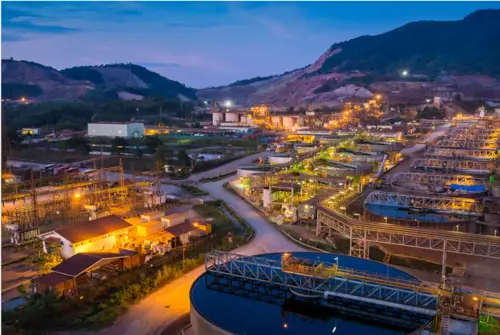The Path to Global Gold Mining Investment: An Exclusive Interview with Lyu Xiaozhao, Director, Vice President, and Chief Engineer of Chifeng Jilong Gold Mining Co., Ltd.
In the vast landscape of the global economy, the gold mining industry has always shone with a unique brilliance. In recent years, amid escalating geopolitical conflicts, rising inflationary pressures, and profound adjustments in the global economic landscape, gold—with its value-preserving and safe haven properties—has increasingly become a coveted asset for central banks, financial institutions, and investors. As gold prices continue to climb, the gold mining market has surged with unprecedented opportunities.

Amid this wave, Chifeng Jilong Gold Mining Co., Ltd. has emerged as a standout in China’s gold mining sector, thanks to its strategic vision, precise market insights, and relentless pioneering spirit. The company has not only solidified its foothold in the domestic market but has also made strides on the international stage, actively expanding its overseas gold resource portfolio and showcasing the ambition and strength of Chinese gold mining enterprises.
Recently, China Gold News conducted an exclusive interview with Lyu Xiaozhao, Director, Vice President, and Chief Engineer of Chifeng Gold, delving into the deeper logic and future trends of gold mining investment and mergers and acquisitions (M&A), green mining development, and the dynamics of international cooperation and competition.
Internationalization of Gold Mining: An Inevitable Choice
In recent years, the internationalization of China’s gold mining industry has become increasingly evident. In Lyu Xiaozhao’s view, this is an inevitable trend driven by the uneven distribution of global gold resources.
He explained that high-quality gold resources are highly concentrated in regions such as Africa, South America, and Central Asia, compelling gold mining companies to venture abroad in search of more resources and reserves and development opportunities.
Lyu pointed out that while China is the world’s largest gold consumer, its domestic gold resources are relatively poor in quality, with insufficient reserves and production growth, leading to a significant supply-demand gap. It is reported that China’s proven gold reserves account for only 3.7% of the world’s total. “Chinese mining companies ‘going global’ to participate in the development and competition for international gold resources is a necessary step to ensure national gold supply security and meet domestic demand,” he said.
In recent years, the Chinese government has actively encouraged enterprises to engage in the Belt and Road Initiative, strengthening energy and mineral cooperation with partner countries, thereby providing robust support for the internationalization of gold mining. Data shows that Chinese gold mining projects now span more than 20 countries worldwide. By the end of 2023, overseas gold production by Chinese mining companies reached 60.378 tonnes, and the top five Chinese gold enterprises collectively held global gold resources of 9,624.56 tonnes, accounting for about 10% of the world’s total. Despite challenges such as political risks, legal disparities, cultural conflicts, and inconsistent technical standards, Lyu believes the long-term benefits of internationalization far outweigh short-term risks.
“Through global expansion, companies can not only secure more resources but also enhance their technological and managerial capabilities, boosting competitiveness in the global market. Additionally, internationalization helps diversify risks, reducing reliance on a single market and enabling sustainable development,” Lyu said.
Gold Mining M&A: Uncovering Potential Value Amid Price Volatility
With gold prices soaring, the global gold mining M&A market has become increasingly active, with asset transactions growing more frequent. According to the Global Mining Development Report, global gold M&A transaction values reached $24.474 billion in 2021 (1,043 deals), $16.618 billion in 2022 (610 deals), and surged to $34.64 billion in 2023 (352 deals). Chinese gold miners such as Zijin Mining, Zhaojin Mining, and Chifeng Gold have accelerated their global resource expansion.
While conventional wisdom suggests that counter-cyclical M&A is key to rapid growth of mining enterprises, Lyu argues that although gold prices may fluctuate in the short term, the long-term trend remains upward. Mining investors, he said, should not be swayed by short-term price movements but should instead focus on long-term value trends, given the inherently lengthy cycles of mining projects.


“In M&A decisions, the focus should not solely be on current gold prices but also on the mine’s potential value, including the land size of the mineral rights, resource quality, and exploration upside,” Lyu explained. In reality, gold prices have a limited impact on M&A valuations. Mine valuations typically use long-term average prices and focus on proven reserves to be scheduled for production for financial modeling. Investors prioritize growth potential—whether additional exploration can extend mine life, whether technological innovation can optimize production and technical parameters, whether process and technical upgrade can improve production efficiency and reduce costs—essentially, whether there is room for further optimization.
Chifeng Gold has adhered to this philosophy in its M&A strategy, consistently increasing its resources and reserves and corporate profitability. Since its A-share listing in 2012, Chifeng Gold has acquired projects such as the Wulong Gold Mine in Liaoning, the Sepon Gold-Copper Mine in Laos, Hanfeng Mining in Jilin, the Wassa Gold Mine in Ghana, and the Xidengping Gold Mine in Yunnan—each with significant exploration potential. For example, the Sepon Gold-Copper Mine covers an area of over 1,000 square kilometers and has identified multiple Carlin-type gold deposits and skarn-type copper deposits, with additional potential for orogenic gold deposits, MVT-type lead-zinc deposits, and ionic rare earth deposits. Similarly, Hanfeng Mining discovered large zinc-dominated polymetallic and molybdenum deposits at depth, while the Wassa Gold Mine and Wulong Gold Mine have substantial exploration potential in their peripheral and deep regions.
Thus, in Lyu’s view, mines lacking growth potential are poor investment targets even at low gold prices, whereas those with long-term upside remain strategically valuable even at high prices.
ESG and Cost Control: Dual Challenges in a High-Gold-Price Environment
In the global gold mining market, high gold prices present vast opportunities but bring about risks. Lyu emphasized that in such an environment, mining companies must first focus on cost control, which is key to ensuring sustainable development.
He noted that operational risks ultimately boil down to cost management. Although high gold prices boost revenue, rising costs can erode profits. Companies must implement effective cost-control measures to maintain and improve profitability.
Data shows that the global all-in sustaining cost (AISC) for gold mining in 2023 was approximately $1,295 per ounce, with direct labor costs up about 25% and energy costs up 31% compared to 2019.
Lyu explained that cost control includes both direct and indirect measures. Direct methods include competitive bidding for raw materials and project contracts, while indirect approaches involve technological advancements, automation, production expansion and productivity improvements to reduce labor and fixed costs amortization, as well as minimizing accidents and downtime.
Chifeng Gold has made significant progress in cost control, with its 2023 AISC at $1,179.1 per ounce—a 12% decrease, ranking in the global first quartile. This contrasts with a 7.2% average unit AISC increase among international gold producers. As a result, Chifeng Gold’s profits surged, with year-on-year growth of 78.21% in 2023 and 119.46% in 2024 in terms of net profits attributable to the parent company.
Lyu also stressed that Chinese gold miners must integrate ESG (environmental, social, and governance) considerations into their international strategies—not only for compliance but also to enhance corporate reputation, competitiveness, and sustainability. “Chifeng Gold’s core philosophy is ‘To benefit more people through the development of Chifeng Gold’, so we prioritize community contributions alongside resource extraction,” he said.
For instance, after acquiring the Wassa Gold Mine and Sepon Gold-Copper mine, Chifeng Gold implemented concurrent development and ecological restoration. In Ghana, it supported oil palm plantations on reclaimed land, fostering local industry. In Laos, citrus trees planted on tailings dams restored the environment while creating jobs and economic benefits—exemplifying ESG best practices.
On ecological protection, Lyu noted that it is a critical issue for miners in a high-gold-price environment. No matter at home or abroad, green development is a core topic that mining companies must prioritize.
“While some developing countries have lower environmental standards, in the long run, ecological and environmental protection is an inevitable trend.” He noted that the long-cycle nature of mining development requires companies to focus on environmental protection and sustainable development. Ecological considerations must be incorporated during the project planning phase, such as replacing fossil fuels with green energy and adopting new technologies and equipment. This approach helps avoid high ecological restoration costs later due to environmental issues.
Chinese Miners’ Unique Advantages in Gold Mine M&A
Globalization has made collaboration and competition the norm in mining. Examples include Shandong Gold’s partnership with Barrick Gold at the Veladero mine and Zijin Mining’s joint venture with Ivanhoe Mines at Kamoa-Kakula. Lyu believes that while competition for premium assets is fierce, cooperation remains the industry’s dominant theme.
Internationally, mining companies collaborate through joint ventures and co-development to pool resources and mitigate risks and achieve mutual benefits and win-win results. “M&A and partnerships in gold mining are strategic—some seek resources, others cash flow or profits, all to enhance competitiveness,” Lyu said.
As Chinese gold miners grow, their global influence is rising. Lyu noted that while Western firms often use share swaps, Chinese companies favor cash acquisitions, increasing flexibility and appeal in bidding for premium assets. Chinese miners are also addressing weaknesses by listing overseas, issuing green bonds, and leveraging gold leasing and trade to diversify financing, to provide solid support to their international development.
Moreover, Lyu highlighted Chinese miners’ unique advantages. Unlike Western firms with professional managers hired by a short-term contract, Chinese miners often have long-term employee relationships and flexible incentives. In this sense, Chifeng Gold has been practicing the philosophy of integrating “owners, managers, and workers” into one, fostering greater dedication and efficiency and enabling employees to be fully devoted to the operation and development of the company.
“This unique management model employed by the Chinese gold mining companies improves operational efficiency, enhances cohesion and implementation, optimizes costs and maximizes benefits, allowing Chinese miners to fully exploit resources. It’s a key competitive edge in the global market. With these strengths, Chinese gold miners are poised to thrive in the international arena.” Lyu said.


